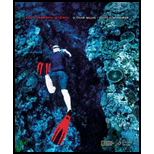
The meaning of “coral reefs” and “coral bleaching.” The reason behind taking care of coral reefs. The major harm that is caused to coral reefs.
Answer to Problem 1CR
The coral reefs are giant colonies of tiny animals polyps. The coral reefs should be taken care of because they prevent floods and erosion. They provide habitats, food, and fish catch. Coral bleaching is the turning of coral polyps into the white skeleton of calcium carbonate after death. The coral reefs have a major threat from runoff of soil, increased temperature, and pH of water.
Explanation of Solution
The coral reefs are the massive colonies formed by tiny animals called polyps. They slowly build reefs by secreting a protective crust of limestone (calcium carbonate) around their soft bodies. When the polyps die, their empty crusts remain behind as a part of a platform for more reef growth.
The coral reefs provide ecosystem and economic services. They act as natural barriers that help to protect 15% of the world’s coastlines from flooding and erosion caused by battering waves and storms. They also provide habitats, food, and spawning grounds for one-quarter to one-third of the organisms that live in the ocean. They also produce one-tenth of the global fish catch. They provide goods and services worth $40 billion a year through tourism and fishing.
The coral bleaching is the situation in which the colorful algae die due to an increase in pollution and water temperature. The corals depend on algae for food. Without food, the coral polyps die and leave behind a white skeleton of calcium carbonate.
The major threat to coral reefs is the runoff of soil and other materials from the land and blocks the sunlight that is required by the algae in shallow reefs for photosynthesis. The other threat is the increased temperature and acidity of water in which the reefs reside.
Want to see more full solutions like this?
Chapter 7 Solutions
Environmental Science (MindTap Course List)
- 1. The field of hydrogeology includes: a. soil water movement b. rainfall runoff and flood generation c. placement of water wells to optimize the quantity and quality of water supplies d. all of the above e. a and c 2. Groundwater occurrence and movement has no direct influence on: a. earthquake activity b. land subsidence c. land slide potential d. hydraulic conductivity e. soil formation f. none of the above 3. In terms of Earth's water budget, groundwater ranks a. higher b. lower 4. Ultimately, the hydrological cycle is driven by: a. geothermal energy fluxes toward Earth's surface b. orographic rainfall due to abrupt changes in elevation c. solar energy fluxes toward Earth's surface d. adiabatic cooling in the atmosphere 5. In the equation below, the variable "Var" refers to: a. void ratio b. pressure head c. hydraulic conductivity d. intrinsic permeability than glaciers and ice caps: P Var = p.garrow_forwardDeep water- waves with constant wavelength Wave movement Approaching shore- waves touch bottom (wavelength decreases) Surf zone (breakers form) Waves touch bottom as they encounter water depths that are less than half a wavelength C E B 00000 00000 Depth is >½ wavelength 0000 0000 Velocity decreases (wave height increases)arrow_forwardActivity 12.1: Wave Characteristics Pg 200 1. Refer to Figure 12.1 and select the letter that identifies each of the following.wave crestwave troughwavelengthwave heightwave base 2. Below what depth would a submarine have to submerge so that it would not be swayed by surface waves with a wavelength of 24 meters?____ mActivity 12.2: Deep Versus Shallow Water Waves Pgs 201-202Refer to Figure 12.1 to answer the following questions. 1. Do particles in deep-water waves trace out circular or elliptical paths? 2. Near the shore in shallow water, do water particles trace out circular or elliptical 3. In shallow water, are water particles in the wave crest ahead of or behind those at the bottom of the wave? 4. As waves approach the shore, do their heights increase or decrease? Do wavelengths become longer or shorter? 5. In the surf zone, is the water in the crest of a wave falling forward or standing still? 6. What is the velocity of deep-water waves that have a wavelength of 46 meters and a…arrow_forward
- Subject: Hydrogeology Please answer the question correctly and in detail and show all workarrow_forwardSubject: Hydrogeology Please answer both parts of the question correctly and in detail and show all workarrow_forwardDiscussion Question: Climate Change A+ The link below explains how scientists study past climates. After the introduction, there are 6 more links within the web page. Please go over each of the six links. Then, write one paragraph about each link explaining what you learned in your own voice. You should end up with 6 paragraphs total. http://earthobservatory.nasa.gov/Features/Paleoclimatology/paleoclimatology_intro.php Please always write in your own words and hence, your own voice. Plagiarism is completely unnecessary.arrow_forward
 Applications and Investigations in Earth Science ...Earth ScienceISBN:9780134746241Author:Edward J. Tarbuck, Frederick K. Lutgens, Dennis G. TasaPublisher:PEARSON
Applications and Investigations in Earth Science ...Earth ScienceISBN:9780134746241Author:Edward J. Tarbuck, Frederick K. Lutgens, Dennis G. TasaPublisher:PEARSON Exercises for Weather & Climate (9th Edition)Earth ScienceISBN:9780134041360Author:Greg CarbonePublisher:PEARSON
Exercises for Weather & Climate (9th Edition)Earth ScienceISBN:9780134041360Author:Greg CarbonePublisher:PEARSON Environmental ScienceEarth ScienceISBN:9781260153125Author:William P Cunningham Prof., Mary Ann Cunningham ProfessorPublisher:McGraw-Hill Education
Environmental ScienceEarth ScienceISBN:9781260153125Author:William P Cunningham Prof., Mary Ann Cunningham ProfessorPublisher:McGraw-Hill Education Earth Science (15th Edition)Earth ScienceISBN:9780134543536Author:Edward J. Tarbuck, Frederick K. Lutgens, Dennis G. TasaPublisher:PEARSON
Earth Science (15th Edition)Earth ScienceISBN:9780134543536Author:Edward J. Tarbuck, Frederick K. Lutgens, Dennis G. TasaPublisher:PEARSON Environmental Science (MindTap Course List)Earth ScienceISBN:9781337569613Author:G. Tyler Miller, Scott SpoolmanPublisher:Cengage Learning
Environmental Science (MindTap Course List)Earth ScienceISBN:9781337569613Author:G. Tyler Miller, Scott SpoolmanPublisher:Cengage Learning Physical GeologyEarth ScienceISBN:9781259916823Author:Plummer, Charles C., CARLSON, Diane H., Hammersley, LisaPublisher:Mcgraw-hill Education,
Physical GeologyEarth ScienceISBN:9781259916823Author:Plummer, Charles C., CARLSON, Diane H., Hammersley, LisaPublisher:Mcgraw-hill Education,





